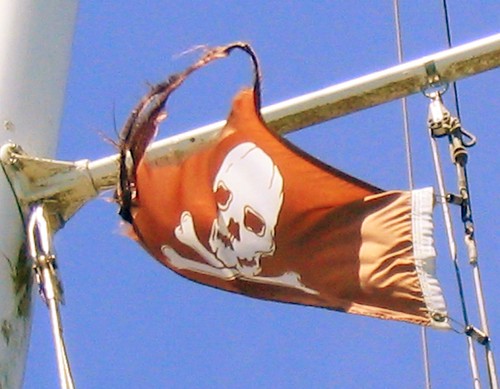
Aharr’ Me Maties
Sailing is a mystery to many of us land loving creatures. Sailboats are not usually seen in suburban backyards and many are only seen on the TV or in magazines. Sailing has its distinct language which can sometimes be as foreign to us as Latin. “Hoist the mailsail” “Batten down the hatches” and “Avast ye landlubbers” are all pirating slang we can affect at a fancy dress party, but what does it all mean? Let’s explore the nautical world’s language for a better understanding.
Talk Like A Proper Pirate Ye’ Landlubber
Some comical pirating terms are “Shiver me timbers” which is derived from 18th Century nautical slang, ‘shiver’ meaning surprise or shock and ‘timbers’ representing the timber frame of a ship. “Avast ye landlubbers” is originally from the Dutch “hou’vast” meaning “hold fast” (perhaps during docking) and “lubbers” lubber was an old English word for slow and clumsy. It could also be the colloquial British West Country accent for “land lovers” as “Blackbeard” or Edward Teach was originally from Bristol. The traditional pirate accent of “Aarrha me ‘arties” is a Cornish accent which was typically during the 17th and 18th century a lunching bay for privateers and pirates attacking ships in transit from the Caribbean and Americas. “Batten down the hatches”, means to fasten down a ship’s hatches during bad weather, with a batten, strips of wood comprising a grate, which would ventilate the lower portion of a ship. 
The Serious Stuff
Although pirating slang is fun to play with, practical sailing terminology is more important for every beginner sailor to understand. You have to think and act fast in stormy weather to get the job done, and nautical terms acts as shorthand to keep the crew safe. As you step on our boat and walk toward the back we encounter our first two sailing terms. The entrance from the front is the bow, the part that faces forward into the sea. Once you have entered the bow, you would then walk towards the aft, which is the back of the boat. Now if you imagine that you are facing the bow and looking at the blue ocean water straight ahead, to point members of the crew’s attention to the right, you would instruct your fellow sailors to look starboard. To look to the left of the bow, you would instruct your fellow sailors to look port.
Technical Terms
Understanding some mechanical terms for operating a boat will help you gain your sea legs and get you on your way to becoming a fully-fledged boatswain, or crew member in charge of the deck. There is the mainsail, which propels the yacht forward, the hull of the boat which is the shell of the craft, the stern (aft-most) or back most part of the ship. An easy one is the rudder, the small wooden, metal, or fiberglass piece that sits under the boat and turns and guides the vessel, which is connected to the wheel or helm of the vessel, which in turn steers the rudder.
Full Speed Ahead Captain
Other parts of the ship include the boom, which is the horizontal pole connected to the mast. By manually turning the boom your hope is to capture the maximum wind available. You want to turn your boom to the windward side, or to the side the wind is blowing. The leeward side is the one opposite of the blowing wind. Hopefully with a few of these sailing terms under your belt you will be a sea-faring salty dog in no time at all Jim lad.
Whether you be ship shape, or a Bilge-sucking addlepate check out these fine sailing courses matey.

